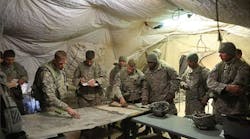by John Rhea
WASHINGTON — The defense industry is enjoying remarkably good health. Industry leaders are responding not only to the military services' reorientation to peacekeeping missions, but also to the need to respond to two major regional conflicts — the so-called 2MRC concept, as reaffirmed in the 1997 Quadrennial Defense Review, or QDR.
The challenge to the incoming administration is to prevent any disruption of this process. That means continuing the steady growth of the U.S. Department of Defense's (DOD) two "investment accounts," research, development, test, and evaluation (RDT&E); and procurement. It also means preserving the 1994 acquisition reforms of former Defense Secretary William Perry.
DOD leaders are expected to increase these two accounts over the coming decade by 0.6 percent each year, say leaders of the Government Electronics & Information Technology Association (GEIA), a sector of the Electronic Industries Alliance, in their annual 10-year forecast presented Oct. 31 in Arlington, Va. GEIA officials say these accounts should grow over the next 10 years from $105 billion to $112 billion, as measured in 2001 dollars.
Last year's big news was that U.S. military procurement broke the $60 billion barrier, which the service leaders had been desperately seeking. Now, according to GEIA, that should rise from $63 billion to $70 billion by 2010. RDT&E is due to remain flat over the period at $42 billion. Total DOD budgets over these 10 years, driven by greater demands for military pay and benefits and by greater operations and maintenance costs to support aging equipment, should rise about 1.2 percent annually from $300 billion to $330 billion, according to GEIA figures.
Moreover, defense spending, which is considered one of the discretionary accounts in the federal budget, is due to maintain a constant share of the overall budget as total federal outlays approach $2 trillion by 2010 to pay for the high-visibility items of Social Security, Medicare, and Medicaid.
Electronics spending
Of much greater interest to the electronics industry is GEIA's forecast of the electronics content within the two investment accounts.
A year ago the organization predicted modest growth for procurement and a decline in annual outlays for RDT&E of nearly $2 billion. This year the forecast is for substantial growth in procurement from $23 billion to $29 billion annually over the period and modest RDT&E increases from $22 billion to $23 billion.
The U.S. peacekeeping role as the world's hyperpower is now accepted internationally, says Cecil Black, manager of market analysis for the Boeing Co. in Arlington, Va., who chaired the annual forecast conference. Moreover, he contends the peacekeeping role is no longer the divisive domestic issue it once was. "The U.S. doesn't sit on its hands and watch the world go by," he comments. "The U.S. leadership role is accepted abroad."
That role was confirmed in the 1997 QDR, but the issue will again be on the table next September in the next QDR. In the election campaign just concluded, both political parties agreed in principle to the new global environment, and the market analysts expect modest growth of the defense budget along the lines of the GEIA projections. Once again, foreign affairs played only a minor role in the past elections.
Implicit in this assumption, however, is brief duration and low number of casualties in future military operations. This has always been the case with democratic societies, whose members have little patience with protracted, bloody conflicts, and whose voters are able to demonstrate their displeasure at the ballot box. This has become even more of a factor in the post-Vietnam era, in which military planners dread what they call a "CNN War." The last thing they want is for members of the public to watch the gory details of war unfold nightly on their television news programs.
This factor, in turn, is driving the new directions of the U.S. military force structure. It will be a Continental U.S.-based force with heavy emphasis on airlift and sealift. It will also be a smaller force than it is today, which increasingly emphasizes a tremendously deadly and efficient fighting force to meet high requirements for operational tempo. This means a broad use of the most advanced electronics.
These are the issues that the new administration must successfully resolve at next year's QDR if the military is to stay on its present path. One great challenge to the new president and his administration is to stay in the background and let the military leaders do what they do best, rather than to try to reshape the process. An unforeseen crisis in an area such as the oil-producing Middle East could change this process, of course, but that would have implications far beyond the defense budget.
This modest growth to meet the more modest demands of the post-Cold War era also dictates what GEIA terms a "flat market" strategy for the defense industry. Companies will have to shed either unprofitable operations and concentrate on what they do best, continue the consolidation at the prime contractor level, or somehow try to take away market shares of their competitors.
With a relatively stable market dominated by well-entrenched participants, the "zero-sum" game of grabbing away market share doesn't look too attractive. Mergers and acquisitions do. In fact, they are likely to be the mechanism for playing this game. Expect them to continue.
The recent acquisition of Minneapolis-based Honeywell International Inc. by General Electric Co., the nation's fifth largest public corporation with revenues of $111 billion last year, coming on the heels of the previous acquisition of certain Lockheed Martin military operations by BAE Systems of Britain, is a logical response to current industry conditions. The resulting economies of scale give the acquiring companies an edge in seizing market share.
The view from the White House could logically be that a shrinking pool of prime contractors automatically means less competition and therefore higher acquisition costs downstream.
This is not necessarily the case. The center of gravity in the defense industry is shifting downward toward the subsystem providers, who increasingly account for a greater percentage of the intellectual property contained in finished systems. The White House planners should be more concerned about a healthy commercial electronics industry than with maintaining competitive shipyards or airframe assembly plants.
Black of Boeing cites a study of three major defense contractors (Boeing, Lockheed Martin, and Raytheon), which had revenues of a little more than $100 billion in both their military and commercial sectors in 1999 and contracted out $43.4 billion to 112,000 suppliers. The new President can't afford to overlook the big three, but those 112,000 suppliers are a priceless national asset too.
On one point everybody agreeds: the international climate is evolving and the U.S. military structure must evolve with it. No President can change the climate, but he can help tailor the American response. In 1996 New York Times columnist Thomas Friedman commented, "No two countries that both have a McDonald's have ever fought a war against each other." A sober footnote to Friedman's comment: there was a McDonald's in Belgrade during U.S bombing of Serbia.


